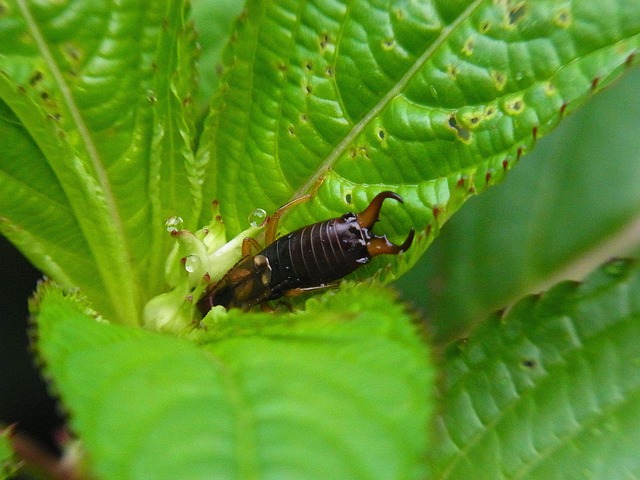Earwigs, though beneficial outdoors, become pests indoors. To safely remove them using eco-friendly methods, seal entry points, control moisture and ventilation, plant herbal repellents, keep a clean home, use gentle removal techniques, and dispose of affected items properly. Regular vacuum cleaning and laundry help prevent reinfestation. Essential oils and diatomaceous earth are effective, non-toxic solutions. Maintaining a clutter-free environment further discourages earwigs and other pests.
Are earwigs invading your indoor spaces? Don’t panic! This guide offers a comprehensive, yet gentle approach to dealing with these pesky critters. We’ll first demystify earwig behavior and habitat, empowering you to understand their preferences. Next, discover effective, eco-friendly prevention strategies to deter them naturally. Learn safe removal techniques for when they do appear, ensuring both your peace of mind and the creatures’ well-being. Finally, explore post-removal care and environmental considerations for a lasting solution to earwig visits. Uncover the secrets to eco-friendly earwig solutions here.
Understanding Earwigs: Behavior and Habitat
Earwigs are small insects known for their distinctive appearance and often perceived as pests due to their tendency to invade indoor spaces, especially in damp areas like bathrooms and kitchens. Understanding their behavior is crucial when it comes to effective yet safe removal. These creatures are primarily nocturnal and tend to hide in dark, narrow spaces during the day. They are attracted to moisture and are excellent climbers, allowing them to navigate walls and floors effortlessly. Earwigs feed on organic matter, including plants, fruits, and even dead insects, making them beneficial in their natural habitats but a nuisance when they enter homes unexpectedly.
Knowing their preferred habitats helps in devising eco-friendly earwig solutions. Sealing entry points, maintaining good ventilation, and reducing moisture levels can deter these insects from invading your indoor spaces. Natural repellents like lavender, mint, or citrus oils can also be effective without causing harm to humans or pets. Regular cleaning and removing potential food sources will further discourage earwigs from settling in, ensuring a peaceful living environment.
Eco-Friendly Prevention Strategies
To prevent earwigs from invading your indoor spaces, consider implementing eco-friendly strategies that promote a harmonious coexistence with these creatures. One effective approach is to eliminate potential entry points by sealing gaps and cracks around windows, doors, and utility pipes using caulk or weatherstripping. This physical barrier stops earwigs from finding their way inside. Additionally, maintain proper ventilation in your home, as earwigs are attracted to moisture and decaying organic matter. Ensure good air circulation, especially in humid areas like bathrooms and kitchens.
Planting certain herbs and flowers known for repelling earwigs can also be an appealing eco-friendly solution. For instance, marigolds, mint, basil, and lemongrass contain natural compounds that deter these pests. Strategically placing potted plants around your home’s perimeter or near entry points can serve as a non-toxic barrier against earwigs. Furthermore, maintaining a clean and clutter-free environment reduces hiding spots and food sources, making it less appealing for them to stay indoors.
Safe Removal Techniques
When it comes to safely removing earwigs from indoor spaces, the goal is to use methods that are effective yet gentle on both the pests and your environment. Eco-friendly earwig solutions offer a humane approach by avoiding toxic chemicals. One such method involves using natural repellents like essential oils, such as peppermint or cedarwood oil, which can be sprayed around entry points and infested areas. These scents often act as deterrents without causing harm.
Another safe technique is physical removal using tools designed for this purpose, like a pair of long-handled tweezers. Carefully locate the earwigs—they tend to hide in dark, moist spaces—and gently pluck them out. This method requires patience and precision but ensures no chemicals are introduced into your living space. Additionally, sealing gaps and cracks where earwigs might enter can prevent their return, complementing these eco-friendly earwig solutions for long-term prevention.
Post-Removal Care and Environmental Considerations
After successfully removing earwigs from your indoor spaces, proper post-removal care is essential to prevent reinfestation. Vacuum or wipe down affected areas thoroughly, focusing on crevices and cracks where earwigs might hide. Dispose of vacuum bags immediately in sealed plastic bags to avoid any potential reintroduction. Regularly launder bed linens, curtains, and other washable items that came into contact with the earwigs to eliminate any remaining eggs or nymphs.
From an environmental perspective, opt for eco-friendly earwig solutions whenever possible. Avoid using chemical pesticides that can be harmful to pets, humans, and beneficial insects. Instead, consider natural repellents like essential oils (e.g., peppermint, citrus, or neem oil) or diatomaceous earth. These methods are effective yet less toxic. Additionally, maintaining a clean, clutter-free environment reduces hiding spots for earwigs and other pests, making your home less inviting to them.
Earwigs may be unwelcome intruders in indoor spaces, but with a combination of understanding their behavior, implementing eco-friendly prevention strategies, and employing safe removal techniques, you can effectively manage these pests. By taking proactive steps and considering post-removal care, you not only rid your home or office of earwigs but also contribute to a healthier environment. Adopting eco-friendly solutions ensures that both your living spaces remain pest-free and the ecosystem outside remains intact.
